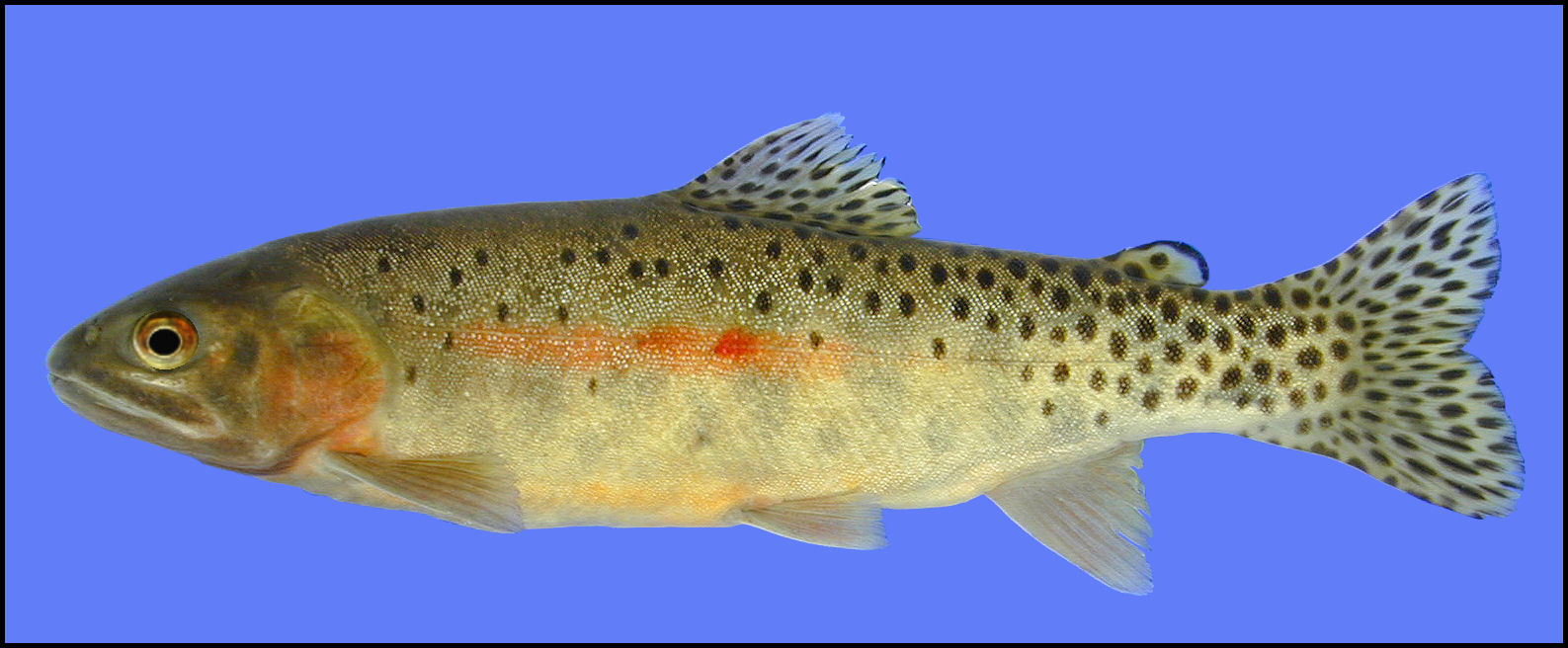|
Picture by Chad Thomas, Texas State University, San Marcos |
||
|
Oncorhynchus clarki cutthroat trout
Type Locality Cathlapootl River, Washington (Richardson 1836).
Etymology/Derivation of Scientific Name
Synonymy Salmo clarki Richardson 1836:225; Behnke 1980:105.
Characters Maximum size: 99 cm TL (Oncorhynchus clarki; Behnke 1980; Page and Burr 1991).
Coloration: Paired fins uniformly brown or reddish but without a white border; deep red to orangish slash on each side of throat along inner side of dentary bone; large spots concentrated on caudal peduncle in adults (O. clarki; Hubbs et al. 2008).
Counts: Lateral scale rows 150-180 (O. clarki; Hubbs et al. 2008).
Mouth position: Terminal (O. clarki; Goldstein and Simon 1999).
Body shape:
External morphology:
Internal morphology: Pyloric caeca present; basibranchial plate (O. clarki; Goldstein and Simon 1999); basibranchial teeth usually present, but small of vestigial (O. clarki; Hubbs et al. 2008).
Distribution (Native and Introduced) U.S. distribution: Current range of the subspecies that occurred in Texas, O. clarki virginalis, includes headwaters of the Rio Grande and Pecos drainages, possibly the headwaters of the Canadian drainage (Behnke 1979; Hubbs et al. 2008).
Texas distribution: Based largely on circumstantial evidence, this species is likely native to Texas (Hubbs et al. 2008); however, O. clarki virginalis (described by Girard (1856) as Salar virginalis), was probably the subspecies that occurred in the state. Thought to have been originally present in at least Limpia and McKittrick creeks and possibly elsewhere in the Davis mountains (Garrett and Matlock 1991; Hubbs et al. 2008).
Abundance/Conservation status (Federal, State, NGO) Hubbs et al. (2008) listed status for Oncorhynchus clarki as Special Concern-Extirpated in Texas. O. clarki virginalis, commonly known as the Rio Grande cutthroat trout and thought to have been the subspecies found in Texas, was listed as Threatened by the American Fisheries Society; categories of threats: present or threatened destruction, modification, or reduction of habitat or range; disease or parasitism; and other natural or anthropogenic factors affecting existence of this species, including impacts of nonindigenous organisms, hybridization, competition, and/or predation (Jelks et al. 2008).
Habitat Associations Macrohabitat: Oncorhynchus clarki formerly abundant in small rivers, gravelly streams, isolated alpine lakes, and estuaries; species has been widely stocked within and outside original range, and is now present in many formerly trout-barren waters, mostly mountain lakes (Behnke 1980).
Mesohabitat:
Biology Spawning season:
Spawning habitat:
Spawning Behavior:
Fecundity:
Age at maturation:
Migration:
Growth and Population structure:
Longevity:
Food habits: Goldstein and Simon (1999) listed first and second level trophic classification for O. clarki as invertivore/carnivore and benthic and drift/whole body, respectively; main food items are insects and small fishes.
Phylogeny and morphologically similar fishes At least 14 subspecies of Oncorhynchus clarki historically, some very distinctive, but indiscriminate stocking has obscured recognition (Behnke 1980; Page and Burr 1991).
Oncorhynchus clarki known to hybridize with rainbow trout (O. mykiss; Behnke 1980). Non-anadromous forms (O. clarki) more restricted to headwaters than O. mykiss (Behnke 1980).
Host Records
Commercial or Environmental Importance
References
Behnke, R.J. 1979. Monograph of the native trouts of the genus Salmo of western North America. U.S.D.A. Forest Service, Rocky Mountain Region, Lakewood, Colorado. Behnke, R.J. 1980. Salmo clarki (Richardson), Cutthroat trout. pp. 105 in D. S. Lee et al., Atlas of North American Freshwater Fishes. N. C. State Mus. Nat. Hist., Raleigh, i-r+854 pp.
Garrett, G.P., and G.C. Matlock. 1991. Rio Grande cutthroat trout in Texas. Texas Journal of Science 43:405-410.
Girard, C. 1856. Notice upon the species of the genus Salmo of authors observed chiefly in Oregon and California. Proc. Acad. Nat. Sci. Phila. 8:217-220. Goldstein, R.M., and T.P. Simon. 1999. Toward a united definition of guild structure for feeding ecology of North American freshwater fishes. pp. 123-202 in T.P. Simon, editor. Assessing the sustainability and biological integrity of water resources using fish communities. CRC Press, Boca Raton, Florida. 671 pp.
Hubbs, C., R.J. Edwards, and G.P. Garrett. 2008. An annotated checklist of the freshwater fishes of Texas, with keys to identification of species. Texas Journal of Science, Supplement, 2nd edition 43(4):1-87. Jelks, H.L., S.J. Walsh, N.M. Burkhead, S. Contreras-Balderas, E. Diaz-PArdo, D.A. Hendrickson, J. Lyons, N.E. Mandrak, F. McCormick, J.S. Nelson, S.P. Platania, B.A. Porter, C.B. Renaud, J.J. Schmitter-Soto, E.B. Taylor, and M.L. Warren, Jr. 2008. Conservation status of imperiled North American freshwater and Diadromous Fishes. Fisheries 33(8):372-407.
Page, L. M. & B. M. Burr. 1991. A field guide to freshwater fishes of North America north of Mexico. Houghton Mifflin Company, Boston, Massachusetts. 432 pp.
Richardson, J. 1836. Fauna Boreali-Americana, or the Zoology of the northern parts of British America, containing descriptions of the objects of natural history collected on the late northern land expeditions under command of Captain Sir John Franklin, R.N. Part Third. The Fish: 1-327. Richard Bentley, New Burlington Street, London. |
||
|
|
||
